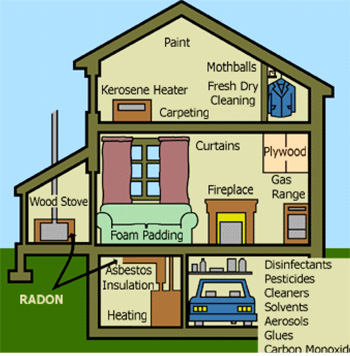Indoor Air Pollutant

It refers to the physical, chemical, and biological characteristics of air in the indoor environment within a home, building, or an institution or commercial facility. Indoor air pollution is a concern in the developed countries, where energy efficiency improvements sometimes make houses relatively airtight, reducing ventilation and raising pollutant levels. Indoor air problems can be subtle and do not always produce easily recognized impacts on health. Different conditions are responsible for indoor air pollution in the rural areas and the urban areas.The levels of pollutants in the air inside homes, schools, and other buildings can be higher than the level of pollutants in the outdoor air. Indoor air pollution comprises a mixture of contaminants penetrating from outdoors and those generated indoors. In the last several years, the amount of scientific evidence has indicated that the air within homes and other buildings can be more seriously polluted than the outdoor air in even the largest and most industrialized cities. Other research indicates that people spend approximately 90 percent of their time indoors. In addition, people who may be exposed to indoor air pollutants for the longest periods of time are often those most susceptible to the effects of indoor pollution. Such groups include the young, the elderly, and the chronically ill, especially those suffering from respiratory or cardiovascular disease.

In the developing countries, it is the rural areas that face the greatest threat from indoor pollution, where some 3.5 billion people continue to rely on traditional fuels such as firewood, charcoal, and cowdung for cooking and heating. Concentrations of indoor pollutants in households that burn traditional fuels are alarming. Burning such fuels produces large amount of smoke and other air pollutants in the confined space of the home, resulting in high exposure. Women and children are the groups most vulnerable as they spend more time indoors and are exposed to the smoke. The World Bank designated indoor air pollution in the developing countries as one of the four most critical global environmental problems. Daily averages of pollutant level emitted indoors often exceed current WHO guidelines and acceptable levels. Although many hundreds of separate chemical agents have been identified in the smoke from biofuels, the four most serious pollutants are particulates, carbon monoxide, polycyclic organic matter, and formaldehyde. Unfortunately, little monitoring has been done in rural and poor urban indoor environments in a manner that is statistically rigorous.

The major factors that determine the quality of indoor air are:
- The nature of outdoor air quality around the building.
- The air exchange rate of the building (ventilation).
- The materials used in the construction of the building (presence of chemicals).
- The activities that go on inside the building (cleaning, cooking, heating etc.).
- Use of household chemicals.
Pollutants
Second-hand smoke
Second-hand smoke is tobacco smoke which affects other people other than the 'active' smoker. Second-hand tobacco smoke includes both a gaseous and a particulate phase, with particular hazards arising from levels of carbon monoxide (as indicated below) and very small particulates (at PM2.5 size) which get past the lung's natural defences. The only certain method to improve indoor air quality as regards second-hand smoke is the implementation of comprehensive smoke-free laws.
Radon
Radon is an invisible, radioactive atomic gas that results from the radioactive decay of radium, which may be found in rock formations beneath buildings or in certain building materials themselves. Radon is probably the most pervasive serious hazard for indoor air in the United States and Europe, probably responsible for tens of thousands of deaths from lung cancer each year.
Moulds and other allergens
These biological chemicals can arise from a host of means, but there are two common classes: (a) moisture induced growth of mold colonies and (b) natural substances released into the air such as animal dander and plant pollen.
Carbon monoxide
One of the most acutely toxic indoor air contaminants is carbon monoxide (CO), a colourless, odourless gas that is a byproduct of incomplete combustion of fossil fuels. Common sources of carbon monoxide are tobacco smoke, space heaters using fossil fuels, defective central heating furnaces and automobile exhaust. Improvements in indoor levels of CO are systematically improving from increasing implementation of smoke-free laws. By depriving the brain of oxygen, high levels of carbon monoxide can lead to nausea, unconsciousness and death. According to the American Conference of Governmental Industrial Hygienists (ACGIH), the time-weighted average (TWA) limit for carbon monoxide (630-08-0) is 25 ppm.
Volatile organic compounds
Volatile organic compounds (VOCs) are emitted as gases from certain solids or liquids. VOCs include a variety of chemicals, some of which may have short- and long-term adverse health effects. Concentrations of many VOCs are consistently higher indoors (up to ten times higher) than outdoors. VOCs are emitted by a wide array of products numbering in the thousands. Examples include: paints and lacquers, paint strippers, cleaning supplies, pesticides, building materials and furnishings, office equipment such as copiers and printers, correction fluids and carbonless copy paper, graphics and craft materials including glues and adhesives, permanent markers, and photographic solutions.
Other bacteria
The role of microbes in the indoor environment is increasingly studied using modern gene-based analysis of environmental samples. Currently efforts are under way to link microbial ecologists and indoor air scientists to forge new methods for analysis and to better interpret the results.
Asbestos fibres
Asbestos is found in older homes and buildings, but it is most dangerous in schools and industrial settings. It was once widely used in shingles, fireproofing, heating systems and floor and ceiling, tiles in older buildings. When asbestos-containing material is damaged or disintegrates, microscopic fibres are dispersed into the air. The risk of lung cancer from inhaling asbestos fibres is also greater to smokers. The symptoms of the disease do not usually appear until about 20 to 30 years after the first exposure to asbestos. Removal of asbestos-containing materials is not always optimal because the fibers can be spread into the air during the removal process. A management program for intact asbestos-containing materials is often recommended instead.
Carbon dioxide
Carbon dioxide (CO2) is a surrogate for indoor pollutants emitted by humans and correlates with human metabolic activity. Carbon dioxide at levels that are unusually high indoors may cause occupants to grow drowsy, get headaches, or function at lower activity levels. Humans are the main indoor source of carbon dioxide. Indoor levels are an indicator of the adequacy of outdoor air ventilation relative to indoor occupant density and metabolic activity.
Ozone
Ozone is produced by ultraviolet light from the Sun hitting the Earth's atmosphere (especially in the ozone layer), lightning, certain electric devices (such as air ionisers), and as a by-product of other types of pollution. Ozone exists in greater concentrations at altitudes commonly flown by passenger jets. Reactions between ozone and onboard substances, including skin oils and cosmetics, can produce toxic chemicals as by-products. Ozone itself is also irritating to lung tissue and harmful to human health. Larger jets have ozone filters to reduce the cabin concentration to safer and more comfortable levels.
Simple Steps to Improve Indoor Air Quality
1. Keep your floors fresh.
Using a vacuum cleaner that has strong suction, rotating brushes, and a HEPA filter ensures that dust and dirt won’t get blown back out in the exhaust. In high traffic areas, vacuum the same spot several times. Don't forget walls, carpet edges, and upholstered furniture, where dust accumulates. For best results, vacuum two or more times each week and wash out your filter regularly.
2. Keep a healthy level of humidity.
Dust mites and mold love moisture. Keeping humidity around 30%-50% helps keep them and other allergens under control. A dehumidifier (and air conditioner during summer months) helps reduce moisture in indoor air and effectively controls allergens, Lang says. An air conditioner also reduces indoor pollen count -- another plus for allergy-sufferers.
3. Make your home a no-smoking zone.
Cigarette smoke contains more than 4,000 chemicals. Research shows that secondhand smoke increases a child's risk of developing ear and respiratory infections, asthma, cancer, and sudden infant death syndrome (SIDS). For the smoker, this addiction causes cancer, breathing problems, heart attacks, and stroke.
4. Test for radon.
Whether you have a new or old home, you could have a radon problem. This colorless, odorless gas significantly raises the risk of lung cancer. Radon is the second leading cause of lung cancer in the U.S. today. If you smoke and your home has high radon levels, your risk of lung cancer is especially high.
5. Smell good naturally.
You may associate that lemony or piney scent with a clean kitchen or clean clothes.But synthetic fragrances in laundry products and air fresheners emit dozens of different chemicals into the air. You won’t find their names on the product labels. Conventional laundry detergents, fabric softeners, dryer sheets, and air fresheners in solid, spray, and oil form may all emit such gasses.

- Bamboo Palm: According to NASA, it removes formaldahyde and is also said to act as a natural humidifier.
- Snake Plant: Found by NASA to absorb nitrogen oxides and formaldahyde.
- Areca Palm: One of the best air purifying plants for general air cleanliness.
- Spider Plant: Great indoor plant for removing carbon monoxide and other toxins or impurities. Spider plant are one of three plants NASA deems best at removing formaldahyde from the air.
- Peace Lily: Peace lilies could be called the "clean-all". They are often placed in bathrooms or laundry rooms because they are known for removing mold spores. Also known to remove formaldahyde and trichoroethylene.
- Gerbera Daisy: These beautiful flowers remove benzene from the air as well as known to improve sleep by absorbing carbon dioxide and giving off more oxygen over night.
Some example of Indoor Air Pollutant:-
- Philodendron scandens 'oxycardium', ( heartleaf philodendron )
- Philodendron domesticum, ( elephant ear philodendron )
- Dracaena fragrans 'Massangeana', ( cornstalk dracaena )
- Hedera helix, ( English ivy )
- Chlorophytum comosum, ( spider plant )
- Dracaena deremensis 'Janet Craig', ( Janet Craig dracaena )
- Dracaena deremensis 'Warneckii', ( Warneck dracaena )
- Ficus benjamina, ( weeping fig )
- Epipiremnum aureum, ( golden pothos )
- Spathiphyllum 'Mauna Loa', ( peace lily )
- Philodendron selloum, ( selloum philodendron )
- Aglaonema modestum, ( Chinese evergreen )
- Chamaedorea sefritzii, ( bamboo or reed palm )
- Sansevieria trifasciata, ( snake plant )
- Dracaena marginata , ( red-edged dracaena )
Conclusion
Indoor air pollution is one of the major problems that we have to solve since we spend a large part of our life indoors. We should take all necessary precautions to eliminate or minimize the harmful effects of indoor air pollution.